Alex Wissel
Thymostraining
09.11.2019 - 19.01.2020
Opening: 8th November, 6pm
A barricaded train station in Thuringia, far away signs of a village. The sky is closing in dark and mighty; it begins to rain. How do we ever get away from here again? However, we want to get there first! A taxi drives us through the deep, German forest towards Kyffhäuser, towards the monument. It is pouring, on the serpentines towards us rattle rocker gangs on Harley Davidsons, long white beards. The radio program of the Mitteldeutscher Rundfunk broadcasts from a local festival nearby. There, a live role-play takes place; the population plays the Battle of the Nations of 1813. Residents jump through the streets in historical costumes, reports the outside reporter. Rioting hordes attack the village, a woman speaks into the microphone. She was afraid that they would destroy everything — also, their dear harvest. Then the Puhdys sing elegiacally of a curtain that has fallen, that the winds turn and people walk, but "history remains, nobody takes it from us anymore." Then we are there.
What is going on at the Teutonic tourist hotspot Kyffhäuser Monument, on an ordinary Saturday afternoon? Mineral stones, rock crystals, German flags, crossbows, dream catchers, bratwurst for 1.50. A wooden sign says "Heimat" (native land) and "Wir schützen sie, weil sie dem Volke gehört, weil sie unserem Volke gehört" (We protect it because it belongs to the people because it belongs to our people). This is how it was imagined. That is the way it really is. Shortly under the Kyffhäuser, first, eat and shop. One chooses cabbage roulade with red cabbage and Thuringian dumplings and looks at wooden stalls in a semicircle, vendors with braided beards, bee honey, and mead. Next to the Kyffhäuser Hotel, the innkeeper has had a wooden statue of Merkel erected in which many rusty nails are stuck. Visitors, it was reported, were urged for some time to knock them into the Chancellor. A few meters further, Paul von Hindenburg lies in a pit. The stone statue from the Nazi era is said to have been knocked off its pedestal and buried by Soviet soldiers after the Second World War; now nobody really knows what to do with the man who helped Hitler to power. It is also not easy to concentrate here, too heavy everything, too much history, too many monuments, too intact, too broken; it is too quiet here.
The rain has stopped, but the glistening thunderstorm sky makes the light shine like from studio lamps, like in a film production of Regio-TV. It is so crazy quiet here as if someone had turned the television down. The huge trees murmur, violence is in the air. We are talking, we are hiking up, upon the Kyffhäuser. There it stands in phallic splendor, the monument! Inside it, illusionistically carved into the sandstone, Barbarossa sits and spreads, with his most powerful beard, his sleepy and grouchy legs. Barbarossa, aka Friedrich I was German Emperor in the Middle Ages. Little is known about him, but talk is all the more so. He was illiterate; at the end of the twelfth century, he once invited 40,000 knights plus servants to one of the biggest parties of the Middle Ages in Mainz and united the Holy Roman Empire of the German Nation, which then extended as far as Sicily. He died on a crusade on the Turkish river Saleph. However, what does dying mean? Legend has it that Barbarossa dwells directly below us, in an underground cave castle and snores, until Germany is united again. Then Barbarossa gets up to establish another golden age. It goes without saying that this will be not only golden but also German.
The fact that the medieval Red Beard sits and sleeps so big and famous here is due to the Prussians. Shortly after Wilhelm I's death, people were desperately looking for new stories of how to sell one’s own and perform tradition in the newly united empire. The state power built on civil service and military lacked pathos and myth. In addition, the enemy
pushed social democracy on the domestic front. One had to set an example. The Kyffhäuser Monument, which the imperial loyalists had built between 1890 and 1896 by the Düsseldorf architect Bruno Schmitz on the edge of the Thuringian Forest, was now thought of as a direct link to the identity-creating Middle Ages. It was a time when artists could make themselves useful. The Germania von Niederwald, the Hermannsdenkmal near Detmold, and many other memorials were placed gigantically in the German landscape during this time to construct a national history, at the end of which the present-day stands. At the same time, great emperor and artist festivals were celebrated to transform this story into "living images" with the help of actors until its essence was completely internalized. The German myth was born. The German being was born.
Düsseldorf was regarded as the center of these enormous social events and folk festivals, at which current politics were skilfully woven into the newly founded historical science and at the same time, enabled the public to experience the new national narrative immersively. On the exorbitant site in the Kyffhaeuser Mountains, a monument to the founder of the German Empire in 1871 is now enthroned above the Barbarossa monument on a huge horse. This reference to the Staufen Emperor thus leads the larger-than-life Wilhelm I to appear as the executor of the German Reich unit and legitimate heir to the Holy Roman Empire of the German Nation.
Björn Höcke has stood here also several times. Once a year, the völkisch-rechtsnationale (ethnic-national right), the so-called wing of the AfD, meets under the monument and celebrates a festival of self-assurance.
For Höcke-friend Kalbitz, the Kyffhäusertreffen is a patriotic power and rest center in which comrades can recharge their batteries with myth among like-minded people and then go back into battle freshly fortified. You need a lot of rest for a lot of anger. The survival of the people depends on the anger of the people. That is what AfD philosopher Jongen says.
For him, the Federal Republic suffers from a "thymotic undersupply." He diagnoses poverty of anger and rage among Europeans. Thymos is an ancient Greek word whose meaning fluctuates between courage, anger, and indignation. Barbarossa was angry; he looks angry. The landscape is quiet, the emperor angry. Only when eagles instead of black ravens circle over the Kyffhäuser does Barbarossa wake up. Exactly eight hundred years after his death, the turning point and reunification of Germany took place. Did he get up? He did not. That was all still much too small.
The desire for a re-enchantment of the world is great today. Romanticism emerged as a counter-movement to the intellectual rule of the Enlightenment and the Industrial Revolution. Two hundred years later, in the shadow of the digital revolution based on numerical codes, a new, black and often also brown romanticism emerges, which is indulged in at knightly games on lonely castles, where right-wing national esotericists emulate old German noble families or wall themselves in even more radically as citizens of the Reich. That is what it is all about when Höcke proudly apologizes in a ZDF interview that was broken off shortly afterward for his language 'going into the poetic.' In this sphere of whispering and free art, which he claims for himself, Nazi terms are ultimately also a matter of interpretation. He does not want any more memorials; he wants German monuments. From everywhere, they call for modified historiographies in which the renaissance is no longer the bright, clear morning of world history, but the beginning of cold, clear evil. Preferred are the Middle Ages, when the forest witch was still waving, the last sense. The AfD people want something quasi magic, ritualistic, religious. What about Hermann? Around the personified Germania, the figures of art, legend, history, and poetry gathered at the artists' festival in order, under the guidance of art, to depict the events of German history in pictures. A game of history. National cuisine, costumes, roots.
Once you have climbed the 247 steps of the spiral staircase in the tower and stand to gasp above in the fresh air, then it is suddenly there: Germany, as far as the eye can see. The shiny yellow fields and dark green meadows, squarely placed in the landscape like a tin cake. In between, next to, behind: forest. The beeches, the oaks, the spruces, the pines, the firs, the poetic, the wild, describe the German forest. Up here, not only the Kyffhaeuser Mountains but also the Harz can be seen; to the north, you can see the so-called Golden Aue. And then, of course, to the south: the dark Thuringian Forest. It all feels big, and you feel small. It is incredibly quiet here.
- Timo Feldhaus & Alex Wissel
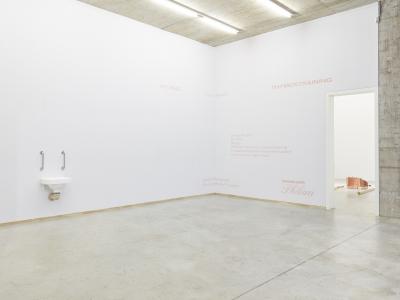
Alex Wissel
mixed media
150 x 50 x 46 cm
Courtesy of the artist and Ginerva Gambino, Cologne
Foto: Paul Schöpfer
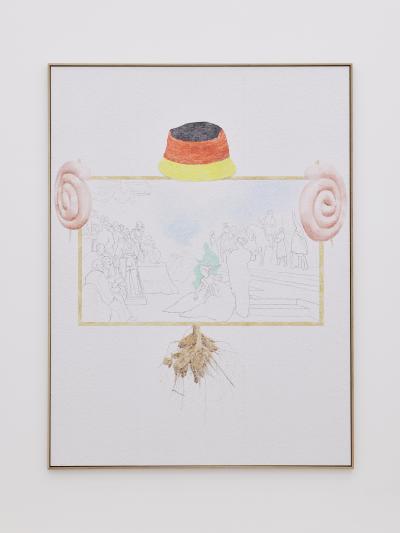
Alex Wissel
coloured pencil on paper and wallpaper, Dibond, oak frame
200 x 150 cm
Courtesy of the artist and Ginerva Gambino, Cologne
Photo: Paul Schöpfer
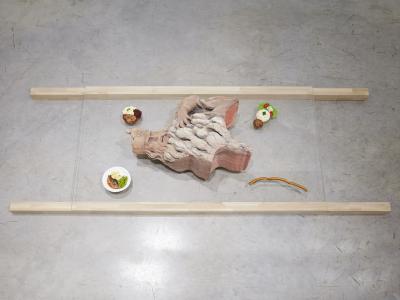
Alex Wissel
44 x 120 x 300 cm
Courtesy of the artist and Ginerva Gambino, Cologne
Photo: Paul Schöpfer
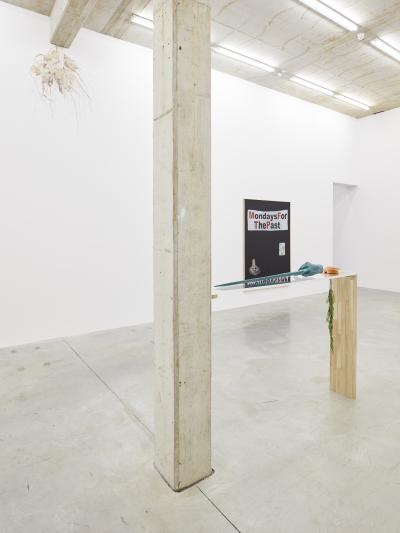
Alex Wissel
Photo: Paul Schöpfer
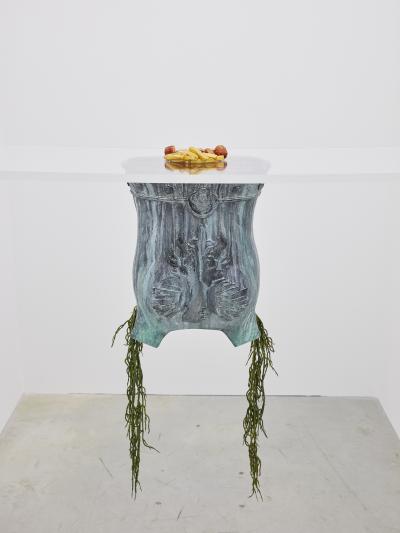
Alex Wissel
150 x 186 x 50 cm
Courtesy of the artist and Ginerva Gambino, Cologne
Photo: Paul Schöpfer
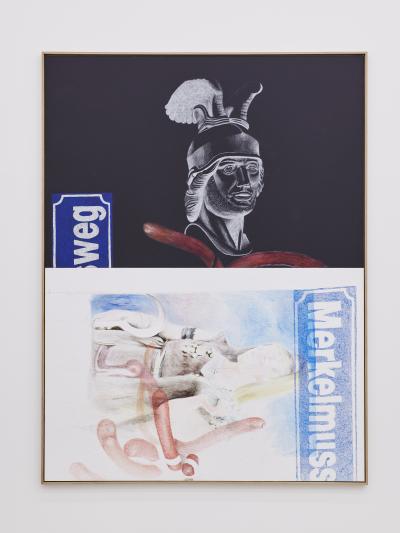
Alex Wissel
coloured pencil on paper and wallpaper, Dibond, oak frame
200 x 150 cm
Courtesy of the artist and Ginerva Gambino, Cologne
Photo: Paul Schöpfer